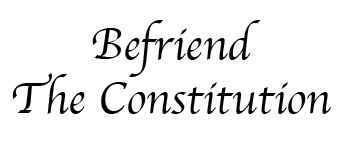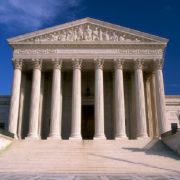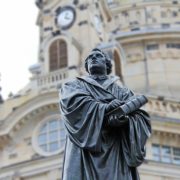In 1553, Mary I was crowned Queen of England. A Catholic, she quickly reinstated Catholicism as the state religion. Over the next five years she had over 280 Protestants burned at the stake for heresy. Mary’s father, Henry VIII, had broken with the Catholic Church just 20 years earlier. He had sent scores of Catholics to their deaths, convicted of treason, for refusing to recognize him as superior to the Pope in spiritual matters. Similar scenes played out across Europe for hundreds of years as monarchs took it upon themselves to determine the religious views of their subjects. People of all religious persuasions suffered persecution, imprisonment, torture, and death as monarchs came and went and state religions changed.
Much of the blood shed in the name of religion occurred because people refused to submit to government’s religious control. As George Tucker said: “In vain, therefore, may the civil magistrate interpose the authority of human laws, to prescribe that belief, or produce that conviction, which human reason rejects.” People endured the persecutions, forced by conscience to reject beliefs contrary to their convictions.
The Founders of the United States understood the need to prevent government control of religion. They were well aware of the horrors perpetrated by old world governments in the name of religion. As James Madison stated: “Torrents of blood have been spilt in the old world, by vain attempts of the secular arm, to extinguish Religious discord, by proscribing all difference in Religious opinion.” They saw the necessity of a government that did not force a particular religion on the people. However, the Founders also recognized the vital role religion plays in society. They recognized that only a moral and a religious people are capable of self government. They wanted the government to promote religion in general while not promoting any individual denominations.
The Founders worked to stop the government support of churches that existed in some of the states. At the national level they made sure the Constitution did not grant the national government any authority over religious matters (the national government has only those powers specifically granted in the Constitution). Further, the Constitution specifies that “no religious Test shall ever be required as a Qualification to any Office or public Trust under the United States.” Later, in the Bill of Rights, The First Amendment added important religious protections.
The First Amendment’s religious protections are based on the fundamental principle that people should have full freedom of conscience in matters of religion. We commonly refer to this as simply “freedom of religion.” The First Amendment insures this by prohibiting the government from establishing a state religion and by guaranteeing the free exercise of religion. These complementary protections combine to prevent the government from becoming like the oppressive governments of the old world in matters of religion.
Freedom of religion is the right to follow the dictates of one’s own conscience in all matters of religion. Latter-day Saints are familiar with the words of the Eleventh Article of Faith: “We claim the privilege of worshiping Almighty God according to the dictates of our own conscience, and allow all men the same privilege, let them worship how, where, or what they may.” James Madison expressed the same sentiment when he wrote “Religion then of every man must be left to the conviction and conscience of every man; and it is the right of every man to exercise it as these may dictate”.
So how do we exercise our religious freedom? Robert D Hales has said that true religious freedom has four basics: The freedom to believe, the freedom to share our faith and our beliefs with others, the freedom to form a church, and the freedom to live our faith. He further stated that we must be free to live our faith in the home, the chapel, and in public places. D. Todd Christofferson has said “A robust freedom is not merely what political philosophers have referred to as the ‘negative’ freedom to be left alone. . . . Rather, it is a much richer ‘positive’ freedom—the freedom to live one’s religion or belief in a legal, political, and social environment that is tolerant, respectful, and accommodating of diverse beliefs.”
For the peace and safety of society, freedom of religion must necessarily contain some restrictions. Section 134 of the Doctrine and Covenants teaches that we can freely act upon our religious opinions unless they prompt us “to infringe upon the rights and liberties of others” and so long as “regard and reverence are shown to the laws and such religious opinions do not justify sedition nor conspiracy.” Those restrictions are small when compared to the religious freedoms we gain.
The Book of Mormon explains the concept of people having government protected freedom of religion in Alma 30:7-11: “Now there was no law against a man’s belief; for it was strictly contrary to the commands of God that there should be a law which should bring men on to unequal grounds. For thus saith the scripture: Choose ye this day, whom ye will serve. Now if a man desired to serve God, it was his privilege; or rather, if he believed in God it was his privilege to serve him; but if he did not believe in him there was no law to punish him. But if he murdered he was punished unto death; and if he robbed he was also punished; and if he stole he was also punished; and if he committed adultery he was also punished; yea, for all this wickedness they were punished. For there was a law that men should be judged according to their crimes. Nevertheless, there was no law against a man’s belief; therefore, a man was punished only for the crimes which he had done; therefore all men were on equal grounds.”
Religious freedom is our most important freedom and is protected by the Constitution. It is no coincidence that it is the freedom currently under the greatest attack. Those who would restrict it or take it away know that if they can be successful in this, then they can strip us of our other basic rights. If our constitutionally guaranteed religious freedoms are lost then we will surely suffer as a result. May we each do all we can to defend our Constitutionally guaranteed religious freedoms.
Sources:
James Madison, Memorial and Remonstrance against Religious Assessments, 20 June 1785
St. George Tucker, View of the Constitution of the United States with Selected Writings, 1803
Elder Robert D. Hales, Preserving Agency, Protecting Religious Freedom, April 2015
Elder D. Todd Christofferson, A Celebration of Religious Freedom, April. 29, 2015
Published July 31, 2016





